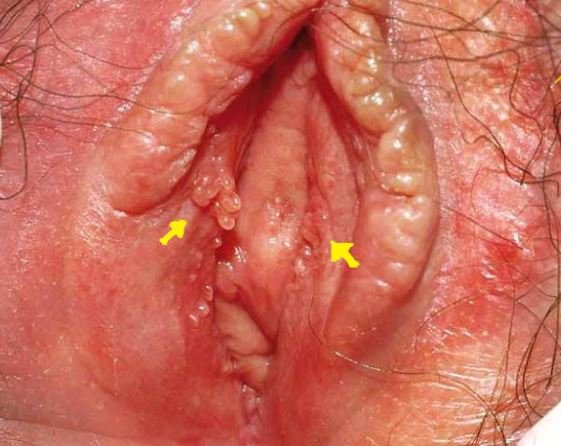Vaginal Bumps
What are Vaginal Bumps?
Bumps may develop in the vagina due to a variety of reasons. Some of these bumps are due to skin ailments while others are due to the presence of sexually transmitted infections (STI) [1, 2].
Bumps may form in the female genital area and these may be itchy, tender or painful. These bumps may be caused by some ailments of the skin, but most of the time, vaginal bumps are caused by STIs. They may appear as red or flesh colored but they may change their appearance.
It is important to have them evaluated in order to identify the treatment that is required and avoid the spread to sexual partners. Figure 1 shows an example of vaginal bumps [1, 2, 3].

Figure 1- Vaginal Bumps
ICD 10
The ICD-10-CM 2016 code that can be utilized for the diagnosis of vaginal bumps is N89.8. This code for any non-inflammatory conditions of the vagina [4].
Causes
Bumps on the vagina caused by any of the following etiologies:
Vaginal cysts
These sac-like structures are filled with either fluid, air or a hardened substance. Some of the most common types of vaginal cyst are Bartholin’s gland cyst or Gartner’s duct cysts. These bumps are usually painless and do not change in size [2, 5].
Hemangioma
Hemangiomas are overgrown blood vessels clusters. These are blue, purple or red bumps that may develop anywhere in the body. These bumps may have been made up of endothelial cells but they are not known to be cancerous [2, 5].
Genital herpes
These are small, straw-colored bumps that appear due to a STI that is caused by the Herpes simplex virus. The bumps most commonly develop in the labia and vaginal area. There will be itchiness and burning sensation in the vagina before the bumps will appear. These warts are transmitted through sexual contact with an infected individual. Herpes could not be treated although their symptoms can be managed [2, 5].
Genital warts
Warts are flesh-colored bumps that are due to the Human Papilloma Virus (HPV). If they are untreated, they will grow to resemble a cauliflower. These bumps will not only grow in the vagina but they are also found in the lips, mouth and throat. Aside from sexual contact, these warts may be transmitted when the female genital is touched by a hand that has HPV warts [2, 5].
Skin Cancer
Although they are quite rare, they can be fatal. These bumps are elevated and asymmetrical and their outline is uneven. Bumps of these kind can increase their color and appearance [2, 5].
Signs & Symptoms
Aside from the presence of these bumps, there are other symptoms that may be experienced. There may be itchiness and burning pain at the vaginal area. Vaginal cysts may be infected and this can produce grayish white or cheesy discharge from the cyst. Bumps that are caused by STIs may come with other symptoms such as pain and discomfort when urinating and increased foul-smelling vaginal discharge [2, 3, 5].
Diagnosis
Health history & examination
The sexual history is an important part of the medical history. This would help to assess if the vaginal bumps are caused by a STI. The physical examination will include inspection of the bumps of take note of their characteristics. If the bumps are suspected to be caused by STI, further laboratory testing may be requested by the physician [2, 3].
Vaginal culture
A culture of the vaginal bump may be performed to identify the cause of the infection. It is performed by taking a swab sample for the area and putting it in a culture medium. It is important to note that engaging in any sexual activity or using any vaginal product is prohibited a few days before the test. Douching should be avoided for 24 hours before the test to prevent the spread of infection [2, 3, 6].
Treatment
The treatment that is required depend on the cause of the vaginal bumps. Hemangiomas and vaginal cysts that are small and do not cause any symptom does not require any treatment. But if their size have increased or if they have been bothersome to the patient, they can be excised in the operating room [2, 3, 5].
Those that are caused by a STI are treated with an antibiotic or antiviral. They are advised to complete the treatment to ensure that the pathogen will not develop immunity to the medications.
Pain relievers and anti-itch medications may also be prescribed to relieve other symptoms experienced by the patient. It is also advised the used of barrier contraceptive, such as condom, in engaging in sexual activity to minimize the risk of acquiring the infection [2, 3, 5].
Bumps caused by cancer will be evaluated by the physician to identify its type and stage. The treatment depends on the progression of the condition and may include chemotherapy, radiation therapy or a surgical procedure to remove the vulva [7].
Let us know via comment section if you experience any of these symptoms & have gone for treatment
References
- Buddy MD. (2015). Vaginal Pimples or Bumps- How Do They Look and Treated? Retrieved from Buddy MD: http://buddymd.com/vaginal-pimples-or-bumps-how-do-they-look-and-treated
- Enki Village. (2015). Bumps on Vagina. Retrieved from Enki Village: http://www.enkivillage.com/bumps-on-vagina.html
- Moore, K. (2015, September 11). Female Genital Sores. Retrieved from Healthline: http://www.healthline.com/health/genital-sores-female#Overview1
- Healthline. (2015). Endocervix Culture. Retrieved from Healthline: http://www.healthline.com/health/culture-endocervix#Overview1
- ICD10 Data. (2015). Other specified noninflammatory disorders of vagina. Retrieved from ICD10 Data: http://www.icd10data.com/ICD10CM/Codes/N00-N99/N80-N98/N89-/N89.8
- Me, M. (2009, June 19). Bumps on the Vagina: How to know if it is Serious. Retrieved from Health Central: http://www.healthcentral.com/sexual-health/c/824092/75446/vagina/
- National Cancer Institute. (2015, July 30). Vulvar Cancer Treatment–Patient Version (PDQ®). Retrieved from National Institutes of Health: http://www.cancer.gov/types/vulvar/patient/vulvar-treatment-pdq
